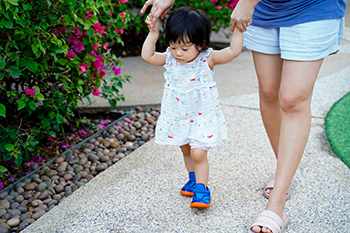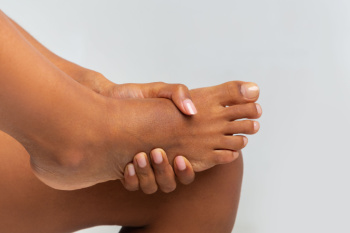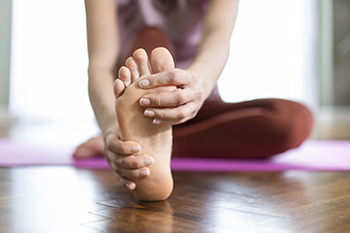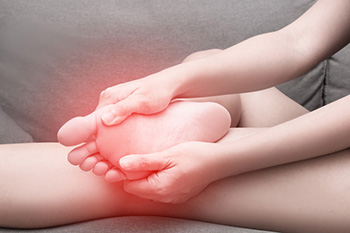Connect With Us
Blog
Items filtered by date: July 2024
Choosing the First Pair of Baby Shoes

The first pair of baby shoes is an exciting milestone, marking the beginning of your child's walking journey. Initially, soft-soled shoes are best, as they allow babies to feel the ground and develop their balance. As your child begins to walk more confidently, choosing shoes with flexible, non-slip soles is important for safety and comfort. Proper fit is vital, as there is enough room for toes to move freely while providing adequate support for growing feet. High-quality materials and construction ensure durability and breathability, keeping little feet healthy and happy. Investing in the right shoes helps support natural foot development, encouraging a smooth transition from crawling to walking. If you have questions or concerns about your child’s foot development, it is suggested that you confer with a chiropodist who can perform a thorough examination, and guide you on choosing appropriate baby shoes.
If your child is experiencing foot or ankle pain, please consult with Paul A. Scotti, D.Ch from West Toronto Foot & Ankle Clinic Inc. . Our chiropodist will assess your condition and provide you with quality foot and ankle treatment.
Common Causes of Foot Pain in Children
While children can experience many of the same foot problems as adults do, some foot problems may be more common during childhood.
Causes of foot pain in children can include:
Deformities that are present from birth, such as flat feet or clubfoot
Sever’s disease, which is an inflammation of the growth plate in the heel bone
Various sports injuries, such as sprains and fractures
Ingrown toenails
Athlete’s foot
Plantar warts
Prevention
It is important to look after the health of children’s feet in order to prevent future problems from arising. Keep your child’s feet clean and dry, trim their toenails regularly, ensure their shoes fit properly, and keep a watchful eye on any symptoms of foot pain, such as limping. If you notice any symptoms or if your child complains of foot pain, a chiropodist can help.
If you have any questions, please feel free to contact our office located in . We offer the newest diagnostic and treatment technologies for all your foot care needs.
Paying Attention to Foot Health
 Maintaining foot health is essential for everyone and particularly important for individuals with diabetes. Start by washing your feet daily with soap and water, and drying them thoroughly, especially between the toes, to prevent fungal infections. Regularly moisturizing your feet helps keep the skin soft and prevents cracking. Choose well-fitted, supportive shoes that provide ample cushioning and arch support. Rotate your footwear to allow them to air out and retain their shape. Avoid walking barefoot in public areas to reduce the risk of infections and injuries. Trim your toenails straight across and file the edges to prevent ingrown toenails. Incorporate foot exercises and stretches into your daily routine to maintain flexibility and strength. Elevate your feet when resting to improve circulation and reduce swelling. For individuals with diabetes, daily foot inspections are imperative to detect cuts, blisters, or other issues early. If you experience persistent pain, discomfort, or notice any abnormalities in your feet, it is suggested that you schedule an appointment with a chiropodist.
Maintaining foot health is essential for everyone and particularly important for individuals with diabetes. Start by washing your feet daily with soap and water, and drying them thoroughly, especially between the toes, to prevent fungal infections. Regularly moisturizing your feet helps keep the skin soft and prevents cracking. Choose well-fitted, supportive shoes that provide ample cushioning and arch support. Rotate your footwear to allow them to air out and retain their shape. Avoid walking barefoot in public areas to reduce the risk of infections and injuries. Trim your toenails straight across and file the edges to prevent ingrown toenails. Incorporate foot exercises and stretches into your daily routine to maintain flexibility and strength. Elevate your feet when resting to improve circulation and reduce swelling. For individuals with diabetes, daily foot inspections are imperative to detect cuts, blisters, or other issues early. If you experience persistent pain, discomfort, or notice any abnormalities in your feet, it is suggested that you schedule an appointment with a chiropodist.
Caring for your feet is not just something done at the chiropodist’s office. Good foot care starts at home. If you would like to learn more about daily foot care practices, please consult with Paul A. Scotti, D.Ch from West Toronto Foot & Ankle Clinic Inc. . Our chiropodist can help you maintain the health of your lower limbs and your mobility.
There are many things that you can do at home to help care for your feet, including:
Wearing shoes and socks that fit properly
Washing the feet daily with soap and water
Drying the feet thoroughly
Applying moisturizer to the soles and heels of the feet
Taking a walk and exercising the feet regularly
Doing foot stretches and strengthening exercises
A chiropodist can help figure out a manageable foot care routine for you to keep your feet healthy. If you have any questions, please feel free to contact our office located in . We offer the newest diagnostic and treatment technologies for all your foot care needs.
Causes and Symptoms of Ingrown Toenails

Ingrown toenails affect people of all ages, particularly teenagers, young adults, and those who are overweight. This painful issue usually involves the big toe but can occur on any toe. Causes of ingrown toenails include improper toenail trimming, as cutting nails too short or into the corners can damage the skin barrier, allowing the nail to grow into the skin. Wearing tight shoes, socks, or tights can increase pressure on the toes, contributing to the problem. Foot injuries, sweaty feet, fungal infections, and genetic factors also play a role, with toenails that are more curved or fan-shaped being more prone to becoming ingrown. Symptoms typically include redness and pain surrounding the affected nail, especially when wearing shoes. If an ingrown toenail becomes infected, swelling can increase, and you may notice blood or pus. Preventative measures include proper nail trimming and wearing well-fitted shoes and socks. Treatment includes minor surgical procedures to remove part or all of the nail, as well as antibiotics if an infection is present. For help with pain from an ingrown toenail, it is suggested that you schedule an appointment with a chiropodist for an exam and treatment.
Ingrown toenails may require medical attention. If you have significant pain or notice signs of infection from an ingrown toenail, please consult with Paul A. Scotti, D.Ch from West Toronto Foot & Ankle Clinic Inc. . Our chiropodist will assess your condition and provide you with quality foot and ankle treatment.
What Is an Ingrown Toenail?
An ingrown toenail occurs when the edges of a toenail grow into the surrounding skin. The toenails of the big toe are usually affected, however, an ingrown toenail can happen on any toe. Sometimes, the area can become infected leading to potentially serious complications. The ingrown toenail may be caused by improper trimming of the toenail, wearing ill-fitting shoes, or injury to the nail.
Symptoms
The symptoms of an ingrown toenail include:
Pain
Swelling
Redness
Warmth
Pus or drainage from the affected nail or a fever may indicate an infection of the area.
Treatment
Treatment depends on the severity of the ingrown toenail. In less severe cases, home treatment may be adequate. Soaking the affected foot in warm water and gently lifting the nail from the skin with a piece of clean cotton can help. In more severe cases, you may need to use topical or oral antibiotics to treat an infection. Surgical removal of the ingrown toenail may be required if more conservative treatments fail.
Ingrown toenails may be prevented by wearing well-fitted shoes and properly trimming the toenails. Toenails should be trimmed straight across and not too short when using nail clippers.
If you have any questions, please feel free to contact our office located in . We offer the newest diagnostic and treatment technologies for all your foot care needs.
Are Bunions Affecting Your Everyday Life?
Causes and Symptoms of Toe Infections

Toe infections can be an unwelcome disruption, especially for those who spend much of their time on their feet. These toe infections often start small but can quickly escalate, making it essential to recognize the symptoms early and seek appropriate treatment. Common signs of a toe infection include pain, redness, swelling, oozing, a bad smell, and a sensation of heat surrounding the affected area. Factors leading to toe infections can include injuries, underlying medical conditions like diabetes, and microorganisms including bacteria and fungi. Ingrown toenails, often caused by wearing tight footwear or improper nail trimming, can also become infected. A yeast and bacterial infection around the toenail results in redness, tenderness, and pus-filled blisters. Athlete’s foot thrives in moist environments and can spread from the toes to other parts of the feet. Preventing toe infections involves good hygiene, wearing properly fitting shoes, and regularly inspecting your feet, especially if you have diabetes. If you believe your toe has become infected, it is suggested that you schedule an appointment with a chiropodist for an exam and treatment.
Toe pain is common and can have a variety of causes. Causes can range from a broken toe to an ingrown toenail. Many types of toe pain can be corrected, but any toe pain that inhibits your activities for an extended period should be discussed with a chiropodist. If you suffer from toe pain, please consult with Paul A. Scotti, D.Ch from West Toronto Foot & Ankle Clinic Inc. . Our chiropodist can help you maintain the health of your feet.
Common Causes of Toe Pain
- Trauma or fracture
- Cuts, sores, or bruises
- Rheumatoid arthritis
- Gout
- Turf Toe
- Morton’s neuroma
- Blisters
- Corns
- Bunions
- Hammertoes
- Ingrown toenails
- Plantar warts
- Athlete’s Foot
Symptoms of Toe Pain
- Toe deformity
- Burning
- Numbness
- Toenail deformity
- Wart or ulcer
- Swelling
- Redness
When to See a Chiropodist
- Bleeding or severe swelling
- Trauma, such as a broken bone
- Discoloration or extreme swelling
- Inability to bear weight
- Persistent pain
- Wounds that won’t heal
Diagnosis of Toe Pain
A chiropodist can conduct a thorough examination of the painful toe or toes in order to determine the best course of treatment. The exam may include assessing the tenderness of the area, taking an X-ray or other diagnostic test, or assessing your gait and range of motion. A discussion of what led to the advanced pain issue may follow. Included will likely be a health history, as well as a list of medications you are taking and other previous injuries you may have sustained.
Treatment for Toe Pain
With such a wide range of possible causes for toe pain, treatment can be varied in scope and length. Sometimes, the chiropodist will recommend lifestyle and activity changes. In cases of trauma or other injuries, X-rays or imaging tests will likely be used to determine the severity of the problem, particularly if any bones have been broken. Treatment may also include injections of pain-relief medication or anti-inflammatory drugs. Certain injuries will require the splinting, bracing, or wrapping of injured toes. Orthotics or special shoes may be prescribed in cases of bone deformities and gait issues. Removal of warts, calluses, and corns may be needed. In other cases, such as with patients who have diabetes or rheumatoid arthritis, ongoing treatment may be required to avoid more serious problems.
Causes and Relief for Pain in the Ball of the Foot

Metatarsalgia is the medical term for pain in the ball of the foot, a condition that can be quite debilitating. This pain is often caused by excessive physical activity, wearing improper footwear, foot deformities, and medical conditions like arthritis or diabetes. Athletes and those who engage in high-impact sports are particularly at risk due to the repetitive stress placed on the metatarsal area. Wearing shoes that lack adequate arch support or cushioning can increase the pain. Relief methods include resting the foot and pain relievers to reduce inflammation. Switching to properly fitted shoes with good arch support and cushioning can significantly alleviate discomfort. Orthotic shoe inserts can help redistribute pressure away from the metatarsal bones. If you have pain in this or any area of your foot, it is suggested that you consult a chiropodist who can effectively diagnose the problem and offer treatment solutions.
Foot pain is a common problem treated by chiropodists. If you have foot pain, please consult with Paul A. Scotti, D.Ch from West Toronto Foot & Ankle Clinic Inc. . Our chiropodist can help you maintain the health of your lower limbs and your mobility.
When you are experiencing foot pain, it’s important to note the type of pain and its location, as this can help determine a diagnosis.
Pain in the top of the foot may be caused by:
Stress fractures
Sinus tarsi syndrome
Extensor tendonitis
Tibialis anterior tendonitis
Gout
Athlete’s foot
Ganglion cysts
Pain in the bottom of the foot may be caused by:
Plantar fasciitis
Foot cramps
Tarsal tunnel syndrome
Plantar fibromatosis
Posterior tibial tendonitis
Stress fractures
Flat feet
Pain on the side of the foot may be caused by:
Ankle sprain
Cuboid syndrome
Peroneal tendonitis
Stress fractures
Bunions
Corns or calluses
Posterior tibial tendonitis
Heel pain may be caused by:
Plantar fasciitis
Achilles tendonitis
Bone spurs
Heel fractures
Retrocalcaneal bursitis
Sever’s disease
Pain in the toes may be caused by:
Gout
Hammertoe
Turf toe
Bunions
Ingrown toenails
Blisters
Arthritis
These and many more conditions can be treated by a chiropodist. If you have any questions, please feel free to contact our office located in . We offer the newest diagnostic and treatment technologies for all your foot care needs.
Blog Archives
- April 2025
- March 2025
- February 2025
- January 2025
- December 2024
- November 2024
- October 2024
- September 2024
- August 2024
- July 2024
- June 2024
- May 2024
- April 2024
- March 2024
- February 2024
- January 2024
- December 2023
- November 2023
- October 2023
- September 2023
- August 2023
- July 2023
- June 2023
- May 2023
- April 2023
- March 2023
- February 2023
- January 2023
- December 2022
- November 2022
- October 2022
- September 2022
- August 2022
- July 2022
- June 2022
- May 2022
- April 2022
- March 2022
- February 2022
- January 2022
- December 2021
- November 2021
- October 2021
- September 2021
- August 2021
- July 2021
- June 2021
- May 2021
- April 2021
- February 2021
- January 2021

